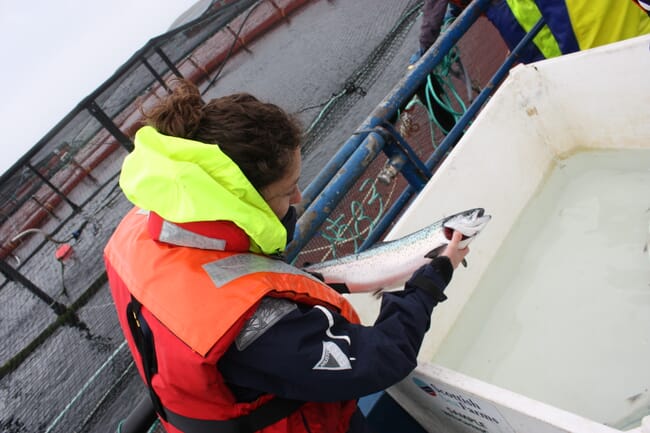The GSI Sustainability Report includes five years’ worth of data, presented for each of the 17 GSI member companies by region, and covers 14 key sustainability indicators – nine environmental and five social.
“As GSI members we are acting on our commitment to improve our social and environmental performance, and we know that transparency is an essential element of responsibility and in getting us to where we want to be in the future,” said Gerardo Balbontin, GSI Co-Chair and CEO of the Chilean salmon producing company Blumar. “Our sustainability reporting is fundamental in building and retaining trust among the people and communities involved in our work, and in holding ourselves accountable to each other.”

Highlights from the report include:
- Over 40 percent of GSI production is now certified to the Aquaculture Stewardship Council (ASC) certification, up from 0 percent five years ago.
- Due to an increase in the use of non-medicinal approaches and sharing of best-practices in sea lice management, over the 5-year period GSI members have reduced the use of medicinal sea lice treatments by 40 percent.
- By continued innovations in the sourcing and efficiency of feed ingredients, GSI members have reduced their use of fish oil and fishmeal by, respectively, 16% and 15% (calculated per forage fish dependency ratio).
- Reports from GSI members on a wide variety of community projects which highlight their significant contribution to local and often remote communities.
- Farmed salmon continues to be one of the most eco-efficient forms of protein production – with the lowest carbon footprint, and lowest feed conversion ratio
"All aspects of food production come with their challenges,” added Aaron McNevin, WWF´s Global Aquaculture Lead. “It is imperative that we all take the responsibility to bend the curve on biodiversity loss. When it comes to aquaculture, one of the fastest growing methods of producing food in the world, this means further reducing its environmental impacts, in this case, of global salmon farming. The GSI's commitment to transparency is evidence that they are committed to building a sustainable future. With five years of environmental data, it is promising to see positive trends emerging. We look forward to the industry continuing to move forward as well as increasing ASC certification to 100 per cent."
Transparency has been identified by the GSI as one of its four pathways to a more sustainable future, alongside cooperation, responsibility and innovation; and speaking about today’s publication, Balbontin commented on why the group has chosen transparency as one of its priority channels.
“Our ability to continue operations and pursue growth opportunities depends on long-lasting and mutually respectful relationships with our stakeholders. Transparent reporting across social, economic and environmental performance indicators not only shows our progress, but also provides the opportunity for us to engage with our stakeholders, respond to questions, and further focus our future performance responsibilities. Within GSI we are also committed to using our model of pre-competitive collaboration to accelerate environmental improvements, and to do that we must also be transparent on our performance with each other,” he said.




